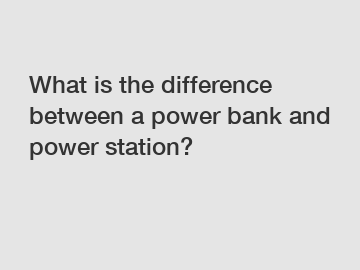What is the difference between a power bank and power station?
What is the difference between a power bank and power station?
Power bank and power station are two terms often used interchangeably in the context of portable charging devices. However, they do have distinct differences in terms of their capacity, functionality, and purpose.
A power bank, also known as a portable charger, is a compact and lightweight device designed to charge smaller electronic devices such as smartphones, tablets, and Bluetooth speakers on the go. It typically consists of a built-in battery and one or more USB ports for connecting the devices that need to be charged. The capacity of power banks can vary, ranging from a few thousand milliampere-hours (mAh) to tens of thousands of mAh. Power banks are usually meant for personal use and are convenient for individuals who frequently rely on their smartphones or other portable devices throughout the day.

On the other hand, a power station is a larger and more robust device that provides a high-capacity power supply for a wide range of devices and appliances, including larger electronics like laptops, cameras, lights, and even small appliances like mini-fridges and fans. Also known as a portable power generator, a power station often comes with multiple output options, including USB ports, AC outlets, and DC outputs, enabling users to charge or power different types of devices simultaneously. Unlike power banks, power stations usually have much higher battery capacity, typically ranging from a few hundred watt-hours (Wh) to several kilowatt-hours (kWh). They are designed to provide a temporary power source for outdoor activities, camping, emergencies, or situations where access to electricity is limited or unavailable.
The difference between a power bank and power station lies in their capacity, functionality, and intended use. While power banks are portable and convenient for charging small electronic devices on the go, power stations provide a higher capacity and are more versatile, catering to a broader range of devices and appliances. The higher capacity of power stations allows them to offer a longer runtime and support larger power loads, making them suitable for a wider array of applications.
In conclusion, the main difference between a power bank and power station lies in their size, capacity, and functionality. Understanding these distinctions helps users choose the right device based on their specific needs. Whether one requires a compact and portable charger for personal use or a more powerful and versatile power source for various devices and appliances, the choice between a power bank and power station will ultimately depend on the intended use and power requirements.
Contact us to discuss your requirements of Shared Power Bank Factory, high quality powerbank rental supplier, shared power bank factory. Our experienced sales team can help you identify the options that best suit your needs.

Comments